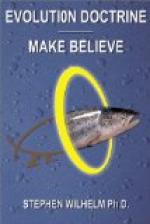Thus at the very outset our simple illustration establishes the most fundamental principle of comparative anatomy. Let us see how it works further. The Manx cat possesses an abbreviated tail, although in other respects it is practically the same as the familiar long-tailed form; the Angora and the Persian differ in having long hair. All of these animals are so much alike in so many respects, and so closely resemble the wild cats, that it is not unreasonable to regard them all as the descendants of the same original wild ancestors, and as the varying products of lines which branched out from the same stock in different directions and at different times. It is, in a word, their “cat-ness” which demonstrates their relationships. But common sense need not stop here. Guided by the facts of anatomical similarity, it convinces us that the dun-colored lion and puma, the striped tiger and the spotted leopard are simply cats of a larger growth whose remoter ancestry is one with that of the previously cited forms. Not until we explore and compare their several systems do we see how thoroughgoing is their uniformity in structural plan. And because reason justifies the view regarding the origin of domestic cats from wild ancestors, the evolution of all the various members of the cat tribe must be acknowledged. These animals exhibit a fundamental likeness, which, to employ a musical analogy, is the “theme” of “cat-ness,” and they are so many variations of this theme.
The members of another tribe of the familiar carnivora display in their own way the same kind of evidences of relationship. The varieties of domesticated dogs differ far more widely among themselves than do common cats, yet their community of ancestry is demonstrated not only by structural resemblances, but also by the striking fact that forms as diverse as the greyhound and the fox terrier can be crossed. Here again there are wild forms, like the wolf and fox and jackal, so like the domesticated members of the dog tribe that we cannot fail to recognize a common “dog-ness” and its significance as evidence of the relationship in ancestry of all these animals.
Extending our survey so as to include the other tribes of flesh-eaters, identical principles come to light. One is compelled to regard the polar and grizzly bears as obvious blood relatives of the brown bear, and even of the raccoon of our own territory. Instead of walking upon their toes like cats and dogs, these animals plant their feet flat upon the ground; and they agree in many other details of structure that place them together, but somewhat apart from the other tribes. The many kinds of seals and walruses and sea elephants form still another group displaying similar bodily characters, but differing more widely from the “cat theme” in these differences. They are all true carnivora, but in the course of their evolution they have progressively changed so as to be adapted to life in the water where they find




